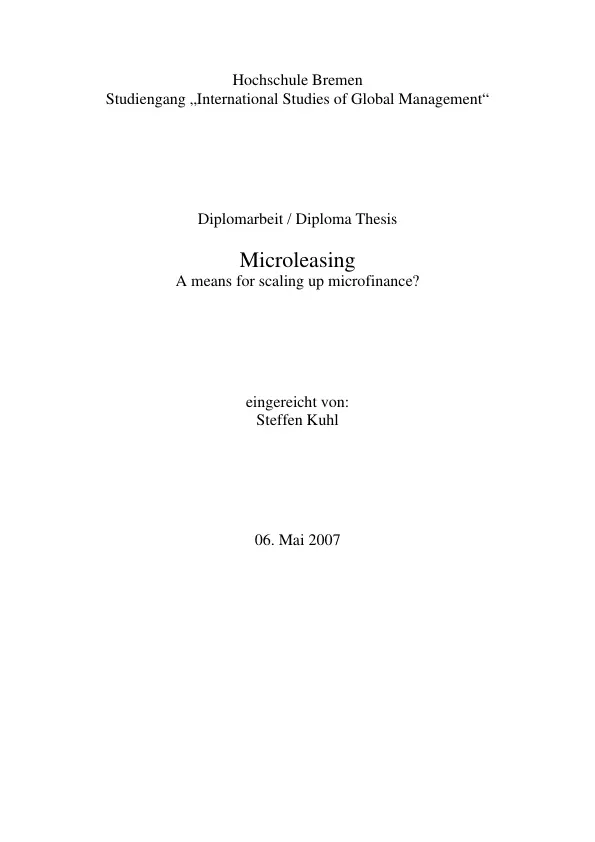Leasing as a means for scaling up microfinance is a relatively new and untapped topic. A lot of information about regular leasing in developed countries is available. In addition, some projects on leasing in developing countries have been successfully carried out. The International Finance Corporation (IFC), for example, successfully pioneered in entering the South Korean market and from there India, Pakistan, Turkey, and Russia. Surprisingly, information on leasing at the very micro-level of such economies is rare.
In times of commercialization and product diversification among microfinance institutions, insurance and remittance services as well as savings products have gained much attention. Leasing still is underdeveloped in that respect. This paper aims at the analysis of leasing in microfinance institutions and its potential to increase and upgrade the institution itself as well as its customers. As there clearly is a shortage of research and data in that field, the author will present the most recent literature available, including the state of microfinance and leasing in developing countries. Due to the lack of academic and practical information, this paper can not contain a complete analysis of all aspects of microleasing. It rather discusses the main features of microleasing with respect to the success factors of microinsurance, microcredit, microsaving and other products already introduced in microfinance institutions. The author will highlight the major opportunities and threats to the microleasing business that are likely to be faced by its stakeholders. The distinctive features of more advanced countries on the one hand and less developed and informal economies on the other hand will be part of the paper, as well.
Inhaltsverzeichnis (Table of Contents)
- INTRODUCTION
- CONTENT
- MAJOR TRENDS AFFECTING MICROFINANCE
- The Millennium Declaration
- The Bottom of the Pyramid (BoP)
- The Role of Innovation at the BoP
- THE CURRENT STATE OF MICROFINANCE
- LEASING AND ITS DEVELOPMENT IMPACT
- The History of Leasing
- The Evolution of Leasing in Developed Markets
- Potential for Leasing as a Development Tool
- MICROLEASING: THE LOGICAL CONSEQUENCE?
- Characteristics of Leasing
- Introduction
- Types of leasing
- Types of risk and risk mitigation strategies
- The range of leased items
- The client perspective
- Provider perspective
- The Leasing Environment
- Potential leasing clients
- Existing and potential leasing providers
- Regulatory and legal situation
- Accounting and taxation
- Repossession
- Rural Leasing and subsidies
- Distinctive Features of Regular, SME and Micro- Leasing & Lending
- Characteristics of Leasing
- SAMPLE CASES
- Introduction and Relevance to this Paper
- Background
- Value Chain Analysis
- Product ranges and target groups
- Terms and conditions
- Selection, approval and purchasing processes
- Repossession, remarketing and residual value management
- Success factors and institutional performance
- Conclusions and Outlook
- STRATEGIC IMPLICATIONS ON SCALING UP MICROFINANCE
- Why MFIs should scale up
- How MFIs should scale up
- Final remarks
- BIBLIOGRAPHY
Zielsetzung und Themenschwerpunkte (Objectives and Key Themes)
This diploma thesis examines the potential of microleasing as a means to scale up microfinance. The paper explores the current state of microfinance, analyzes the development impact of leasing, and delves into the specific characteristics and features of microleasing. It investigates the potential of microleasing for addressing the needs of microfinance clients and analyzes its strategic implications for scaling up microfinance initiatives.
- The potential of microleasing as a tool for scaling up microfinance
- The development impact of leasing
- The characteristics and features of microleasing
- The specific needs of microfinance clients and their suitability for microleasing
- The strategic implications of microleasing for scaling up microfinance initiatives
Zusammenfassung der Kapitel (Chapter Summaries)
The introduction provides a brief overview of the topic and outlines the key questions addressed in the thesis. Chapter 2 examines major trends affecting microfinance, including the Millennium Declaration, the Bottom of the Pyramid concept, and the role of innovation in microfinance. Chapter 3 provides an overview of the current state of microfinance, highlighting its growth, challenges, and opportunities. Chapter 4 explores the development impact of leasing, examining its historical evolution and its potential as a development tool. Chapter 5 delves into microleasing, analyzing its distinctive features, its suitability for microfinance clients, and the key aspects of the leasing environment. Chapter 6 presents sample cases of microleasing initiatives, examining their value chain analysis, success factors, and institutional performance. Chapter 7 discusses the strategic implications of microleasing for scaling up microfinance, examining why and how MFIs should scale up their operations.
Schlüsselwörter (Keywords)
The key themes and concepts explored in this thesis include microfinance, microleasing, scaling up, development impact, leasing environment, value chain analysis, and institutional performance. The paper examines the potential of microleasing to address the specific needs of microfinance clients and its strategic implications for scaling up microfinance initiatives.
- Quote paper
- Steffen Kuhl (Author), 2007, Microleasing - A means for scaling up microfinance?, Munich, GRIN Verlag, https://www.grin.com/document/77297



